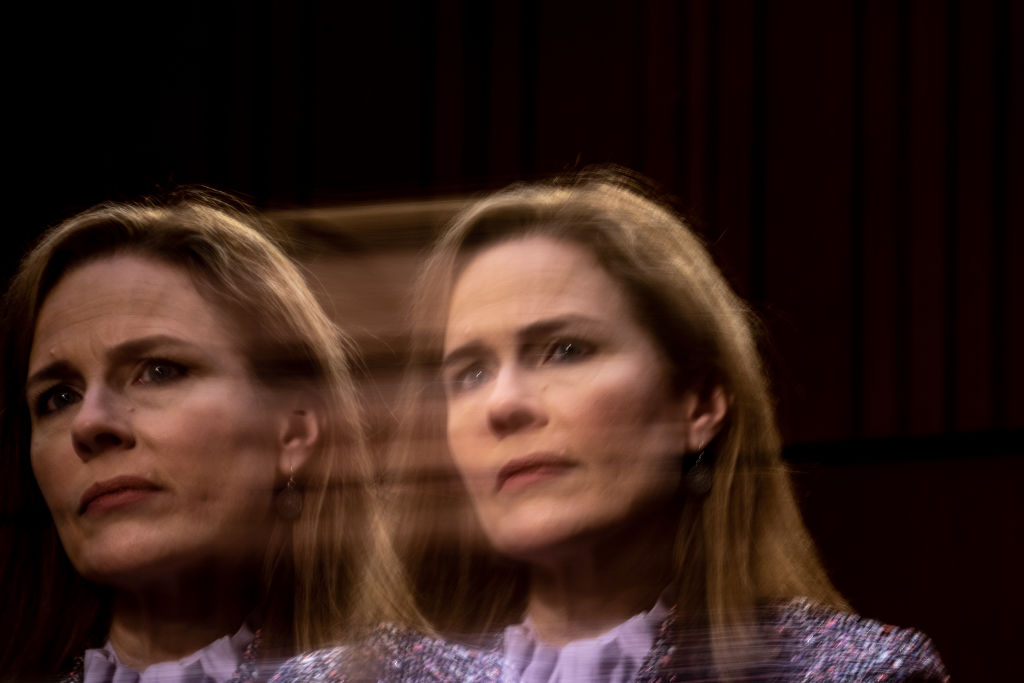Pro-Choice
Related: About this forumSafe Haven Laws Were Never Supposed to Be an Alternative to Abortion
(a must-read to counter the BS)
Safe Haven Laws Were Never Supposed to Be an Alternative to Abortion
8/17/2022 by Shoshanna Ehrlich

Despite what Amy Coney Barrett believes, safe haven laws cannot be retrofitted to meet the post-Dobbs crises in abortion access.
During oral arguments in Dobbs v. Jackson Women’s Health Organization, Justice Amy Coney Barrett questioned whether abortion was really necessary anymore given the existence of safe haven laws. (Erin Schaff / Getty Images)
The case of Dobbs v. Jackson Women’s Health Organization has thrust safe haven laws back into the public spotlight. Originally enacted in response to sensationalized cases of young women who had abandoned or killed their newborns, these laws enable a birth mother (or birth father or other relative) to anonymously drop their baby off at a designated location like a hospital or fire station, typically without the risk of being criminally charged with child abandonment or endangerment. From there, a state’s child welfare agency becomes responsible for finding an adoptive home for the surrendered baby. Safe haven laws have done “serious work for the culture of life,” wrote scholar Carol Sanger, serving as “one more connecting dot in a larger enterprise that seeks to blur the boundaries between prenatal and postnatal life.” But safe haven laws were never intended to be a literal alternative to abortion—that is, not until Amy Coney Barrett expressly connected the dots during her questioning of Julie Rikelman, attorney for the plaintiff clinics, during oral argument in Dobbs.
. . . . .
As many have recognized, Barrett’s is a cruel and dangerous vision. To begin with, safe haven laws ignore the very real risks and burdens associated with pregnancy and childbirth, particularly for vulnerable communities. As Rikelman pointed out during oral argument, it is 75 times more dangerous to give birth in Mississippi than it is to have a pre-viability abortion, with disproportionate risk for women of color. Accounting for this reality, she stressed that precedent firmly establishes that the abortion right is comprised of two strands—the right to decisional autonomy and to bodily autonomy.
Safe haven laws have also been critiqued on the grounds that, as Jennifer R. Racine argued, they represent an abandonment of “society’s troubled young women” by “deciding that their deep-rooted problems can be saved by an after-the-fact, quick-fix solution.” Put slightly differently, as reported in a recent New York Times article, many experts in the adoption and women’s health fields call for using a contextual approach to evaluate these laws. Viewed in this way, rather than representing a “panacea,” safe haven surrenders can instead be read as “a sign that a woman fell through the cracks of existing systems. They may have concealed their pregnancies and given birth without prenatal care, or they may suffer from domestic violence, drug addiction, homelessness or mental illness.”
. . .
A growing number of states are considering fetal personhood laws that would formally efface the difference between the born and unborn—such as Georgia’s Living Infants Fairness and Equality (LIFE) Act, which allows taxpayers to claim “any unborn child with a detectable heartbeat” as a dependent on their state return in the amount of $3,000. This effort to retrofit safe haven laws as a viable substitution for abortion must be firmly resisted. It is unlikely that Monica Kelsey was including abortion as an option, given her roots in the anti-abortion movement and the fact that the Safe Haven Baby Box hotline refers pregnant callers exclusively to crisis pregnancy centers. Nonetheless, she wisely declared, “When a woman is given options, she will chose what’s best for her.” What’s best must include the option of abortion, free and clear of Barrett’s suggested sequestration of pregnant bodies as vessels.
https://msmagazine.com/2022/08/17/safe-haven-laws-alternative-abortion-adoption/